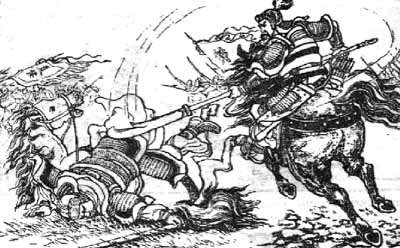
Shown here: Huang Zhong [Sheffield-Maddox] triumphs in Hanzhong [Hanthamton].
|
Main • Commentary • History • Small - Large Map • Links • Games • Books • Download • FAQ • Contact |
||
|
|
When entered the battlefield, they knew what it would take.
Shown here: Huang Zhong [Sheffield-Maddox] triumphs in Hanzhong [Hanthamton]. |

After four hundred years of unity, the ending days of Han Dynasty(1) were a mess. Heroes and strategists throughout the empire emerged and fought for the domains under heaven. No other eras would witness such an abundant amount of extraordinary characters and events.
In the decay of Han, the Yellow Scarves Rebellion started the disorder. Leaders from many places rose up to fight the Yellow Scarves under the banner of the weak imperial government. In this confusion, they defeated the Yellow Scarves, but then each leader had his or her own design and aspiration.
Dong Zhuo, a general from the western frontier, marched east to capital Luoyang and control the Emperor and government affairs. Other leaders angered and banded together to oppose Dong Zhuo, forcing him to move the government to another city, Changan.
Dong Zhuo and the Son of God going west, the leaders turned against each other. They fought for territories:
Yuan Shao
occupied the north;
Sun Ce
mastered the south;
Cao Cao won
the east;
Yuan Shu
reigned in the central;
Gongsun Zan
ruled the northeast;
Liu Yao got
the southeast;
Ma Teng and Zhang Lu
controlled the northwest;
Liu Biao and Liu Zhang
governed the southwest.
At this time, Liu Bei
was a small local official in the northeast.
When the government officials plotted the death of Dong Zhuo, his generals Li Jue and Guo Si captured the Emperor.
Lu Bu, the adopted son and murderer of Dong Zhuo, moved east to fight Cao Cao. Liu Bei got possession of a part of the east. Lu Bu, being defeated by Cao Cao, went to Liu Bei. Sun Ce killed Liu Yao to control the entire south and southeast. Yuan Shao destroyed Gongsun Zan and got the whole north and northeast.
Cao Cao marched to kill Li Jue and Guo Si, and he since then had the government in his hand. He moved the capital back to Luoyang, in central-east. Lu Bu turned against Liu Bei, who sought refuge under Cao Cao's banner.
Yuan Shu made himself emperor. Cao Cao sent Liu Bei to destroy Yuan Shu. Sun Ce joined Cao Cao. The campaign succeeded; Liu Bei occupied the central. Cao Cao, Liu Bei, and Sun Ce marched against Lu Bu and crushed him.
Liu Bei turned against Cao Cao, but got defeated and went to Yuan Shao. Cao Cao defeated Yuan Shao, and Liu Bei went to Liu Biao in the southwest. Sun Ce died; his young brother Sun Quan inherited the south land.
Cao Cao marched against the south; but Liu Biao died, and his territory was lost. Liu Bei now held only a small county in the southwest, when his newly-found strategist Zhuge Liang struck an alliance with Sun Quan. Together, Liu Bei and Sun Quan destroyed the one million soldiers of Cao Cao, who returned north. (The battle of Red Cliffs)
Liu Bei defeated Liu Zhang and Zhang Lu, winning the west. Cao Cao killed Ma Teng in the northwest. Liu Bei occupied the northwest.
And now, three opposing kingdoms were formed: Cao Cao in the north, Sun Quan in the south, and Liu Bei in the west. They marched against each other in many campaigns but without success in destroying each other.
Cao Cao died, leaving his kingdom to his son Cao Pi, who dethroned the current Son of God and declared himself a new emperor(2). Sima Yi emerged as the new leader of the north under Cao Pi. In the west, Liu Bei declared himself another emperor; he died, entrusting his kingdom and his son to the care of Zhuge Liang. In the south, Sun Quan also made himself yet another emperor.
Zhuge Liang marched southwest to put down a rebellion of the local tribes. Then he marched north against Cao Pi. Sima Yi went to oppose Zhuge Liang. In six campaigns, even with the help of Sun Quan, Zhuge Liang harvested no success. He died in the battlefield. Jiang Wei succeeded him to lead the west.
The south marched against the north. Sima Yi died, and his son Sima Zhao defeated that campaign of the south. Sun Quan died; his son succeeded him.
Sima Zhao died. His son Sima Yan dethroned Cao Cao's posterity, and Sima Yan became an emperor. He sent his generals west, and Jiang Wei was defeated. The kingdom in the west fell. Sima Yan moved his army south, and Sun Quan's posterity was defeated. The kingdom in the south fell. The two defeated emperors bound themselves. Sima Yan generously accepted their submissions.
And thus, domains under heaven were united, again, in one rule.
1 Han is one of the most glorious dynasties of China. The Chinese call themselves the people of Han. The name originates from a domain in the central west of ancient China call Hanzhong [meaning Middle Han; in the online edition of Romance of Three Kingdoms, it has the name Hanthamton]. Hanzhong is where Liu Bang [Rucker-Lewis], a man with a humble start, gained his kingship and from there consolidated the whole empire and became the ancestor emperor. Han Dynasty lasted four hundred years and ended in the third century. [See Outlines of Early Chinese History]
|
Main • Commentary • History • Small - Large Map • Links • Games • Books • Download • FAQ • Contact |
||
This page is hosted by ![]()
Get your own Free Home Page